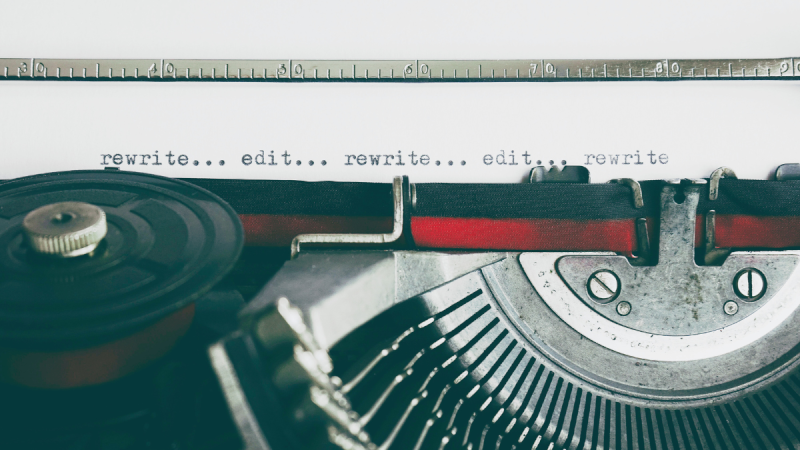Adventures in Editing Part 2: Lessons from a Manuscript Makeover

Alright, alright, alright, I know it sounds cliché but the editor is there to help you. My editor...your editor...all editors want what you want:
The best possible version of your book.
Sometimes that requires a makeover. And when it comes to makeovers, I have a confession to make. I love ‘em.
Before and After headshots, like those in grocery store magazines? Love those! I especially love it when a makeup specialist/stylist takes what on the surface is an unattractive candidate and with a feel for possibility, does a little magic. Voila! Transformation into the full potential of what was always there, hiding in plain sight.
Home makeovers on HGTV? Love those too. It’s always amazing to me to see the interior decorator/reno expert take a dowdy house with “good bones” and with a little imagination turn it into a charmer.
What’s my point? A manuscript revision is kind of like a makeover or a remodel. Only you, the author, are the artist imagining the possibilities, rather than the makeup specialist or the interior designer.
You and your editor.
If you remember from my last blog post, I ended with the teaser: “First Round Edits turned out to be a real learning experience.” Let’s get into the takeaways from my manuscript makeover. They fall into four categories:
- Style Issues
- Use of Trademarks
- Formatting No-Nos
- Tighter Prose
A Matter of Style
Every publisher has their own style guide. Major publishers often use the Chicago Manual of Style (CMOS). Major newspaper the Associate Press Stylebook. Almost all publishers have a House or Corporate Style guide, often using the CMOS as a base or starting point. My publisher does.
Here is a sample of style issues my editor marked up:
Denoting Text Messages
For texting, the House Style is to offset text messages by inserting em dashes. (See endnote for how to insert em dashes in Microsoft Word or Google Docs.)
Flagged: As I left Warnick’s office, I texted Marissa: Wanna come with?
Corrected: As I left Warnick’s office, I texted Marissa: —Wanna come with?—
Currently, the Chicago Manual has no special recommendation for formatting text messages. Some other publishers prefer the use of italics or a different font. Whatever you use, be consistent.
Formatting Numbers in Character Dialogue
To help readers understand how the dialogue will be spoken, spell out most numbers. That especially holds for dollar amounts and numbers at the beginning of a sentence.
Flagged: “...meet you there at 2:00 p.m.”
Corrected: “...meet you there at two p.m.”
Flagged: “9-1-1, what is your emergency?” a female dispatcher said.
Corrected: “Hello, 9-1-1, what is your emergency?” a female dispatcher said.
Flagged: First, Switzerland redeemed $50 million dollars in U.S. Federal Reserve Notes for gold.
Corrected: First, Switzerland redeemed fifty million dollars in U.S. Federal Reserve Notes for gold.
Formatting Inner Dialogue
When characters are speaking to themselves or have inner thoughts, annotate using italics. Keep in mind that when someone thinks an inner thought it’s usually in the present.
Flagged: Thank heavens, the shrill was gone.
Corrected: Thank heavens, the shrill is gone.
Italics for Foreign Words
Except for commonly used foreign words that have become part of everyday English vocabulary (e.g., amigo, genre, ad hoc), italicize foreign language terms.
Before: “Dasvidaniya,” Marissa whispered.
After: “Dasvidaniya,” Marissa whispered.
Use of Trademarked, Copyrighted, or Famous Names
The use of real brand names can lend an air of verisimilitude to your prose. But there’s a catch. You may be liable. Unless you have deep pockets, you’ll want to avoid the possibility of a lawsuit. Especially if you are using a trademark or copyrighted product, or a famous person’s name in a negative light (technical term: “trademark disparagement”).
You’ll also want to avoid brand names where the trademark owner is protecting the brand from becoming a household word (technical term: “trademark dilution”) as this puts the trademark in jeopardy of being canceled due to “genericide.” (Examples: Xerox for copying, Velcro for hook-and-look straps).
Trademarks that now signify a general class of goods through genericizing are okay. (Examples: aspirin, cellophane, kerosene, and thermos).
Trademark Dilution
My publisher avoids using brand names as much as possible.
Flagged: “...chucked the Kleenex in the trash.”
Corrected: “...chucked the tissue in the trash.”
Flagged: Bri pulled the chunky Kotex box from her purse.
Corrected: Bri pulled the chunky sanitary napkins box from her purse.
The publisher’s brand name ban applies particularly to a popular term that has recently entered common parlance. The editor wrote: “Google, in any format, doesn’t want their name referenced only as a search engine and has online searches looking for these infractions.”
Flagged: I could tell she was googling.
Corrected: I could tell she was searching online.
Trademark Disparagement
To avoid a possible negative reference to product quality, the editor flagged the following:
Flagged: a vase of dusty plastic flowers that might have once been red geraniums from Walmart.
Corrected: a vase of dusty plastic flowers that might have once been red geraniums.
References to Movies
My publisher does not allow the mention of “movie brands” or copyrighted song lyrics.
Flagged: I said, “Did you ever see the Mel Gibson movie Conspiracy Theory?”
Corrected: Line deleted from the manuscript.
NOT Flagged: Bri hummed a popular ’80s glam-rock tune by Europe. I couldn’t get the keyboard riff from the Swedish rock band’s “Final Countdown” out of my head.
NO Correction Necessary: The lyrics were never mentioned in the manuscript. Reference to a song title is okay.
Fictional Names
If there is a possibility an organization may end up a villain, consider using a fictitious name. That way you can protect against any potential legal liability for libel or defamation. Early in All that Glisters (ATG), way before it becomes clear who the good guys and the bad are, I mention a company called Sunstake Extractive Industries.
My editor flagged it. She wrote: “This is a fictional name, right? I couldn’t find it online.”
I assured her that the gold mining and refinery conglomerate was fictional. Wholly made up.
To ensure the name didn’t refer to a “real” company, I vetted it through Google and a trademark search using Trademark Genius ( https://trademark-genius.com/ ). Later in ATG, I refer to a company called Aurum Capital Group (also vetted) but that name went through a couple of iterations when I found Aurum Group was already taken. Be safe. Always vet that make-believe name.
Further Exploration
For a couple of different perspectives on style guides for fiction writers, take a look at these two articles:
Should I Use The Chicago Manual of Style for My Book? by Brian A. Klems (Nov 18, 2008)
Web address: https://www.writersdigest.com/dealing-with-editors/should-i-use-the-chicago-manual-of-style-for-my-book
What Is a Writing Style Guide, and Which One Should You Use?
by Dana Sitar (May 8, 2020)
Web address: https://thewritelife.com/writing-style-guide/
And for additional reading on the use of trademarks in fiction (and what could go wrong), see the following:
Who Says I Can’t Use Trademarks In My Fiction? by Matt Knight (May 20, 2017)
Web address: https://www.sidebarsaturdays.com/2017/05/20/httpwp-mep7vddb-hr/
The Case for (Not) Using Trademarks in Fiction by Susan Spann (Feb 18, 2015)
Web address: http://www.susanspann.com/the-case-for-not-using-trademarks-in-fiction/
And the Rankings Are in for the Perfect Author Photo Challenge...
Coming in First

Participant comments:
“Overall it gives a casual feel with the aloha print of your shirt but the jacket shows underlying professionalism. Like you really do know what you’re doing without announcing it too strongly.”
“The background has you wondering what’s just around the corner.”
And Second

Participant comments:
“Good angle, lively and friendly expression, and the simple background will work well against any web page or publication where it is used.”
Finally, Third
Participant comments:
“A wetsuit and just a hint of mysterious background. It’s a winner in my book.”
Based on the feedback, I’ll be updating my social media profile to the #1-ranked look soon. I want to thank all those who participated in the Perfect Author Photo challenge. Loved your ranking comments.
As promised, I’m giving away up to five signed copies of All that Glisters. The name of each person who responded to the challenge was placed in a hat for a random drawing. My lovely wife and fellow author (Dorothy Allred Solomon), picked the five names from the hat, eyes closed.
And the Winners Are...
And the winners are Allison, Amanda, Craig, Melanie, and Scott. You’ll be receiving an email from topperjonesauthor@gmail.com to confirm a mailing address where you’d like your copy of the book sent.
Thanks again to all those who shared their rankings and reasoning.
ENDNOTES
How to Insert an Em Dash
Em Dashes are an old typographer's trick for providing a horizontal line the width of the letter M. (And for a little shorter dash, there’s the En Dash, the width of the letter N.)
For Microsoft Word, select the Insert tab, Symbol menu icon. Then click More Symbols, select the Special Characters tab, and the Em Dash option. But the fastest way to enter the em dash is with a shortcut key. Here’s the combination: Alt+Ctrl+Num - where you hold down the Alt key, the Ctrl key, and the minus sign on the numeric keypad, in that order. That’s what I do.
Or you can use the universal shortcut key combination: Alt+0151 where you hold down the Alt key and type the number 0151 on the ten-key pad.
For Google Docs, go to Insert | Special Characters and type Em Dash in the search box. Or use the universal shortcut key combination: Alt+0151
Join Me
Thanks for reading my blog. You can get more ideas for navigating today’s fast-paced publishing world in my popular email newsletter. Each week, I share insights into the writing craft, tips for further exploration, and the latest news on Hanlon & de la Guerra mystery series. Click the link below now and join us.


